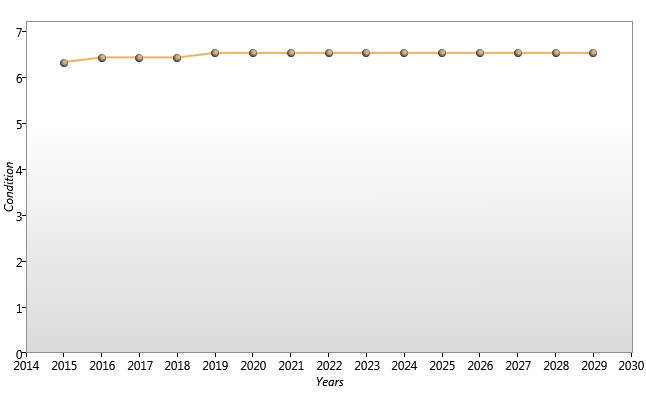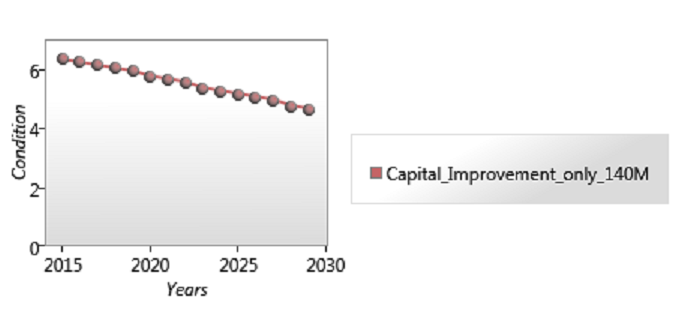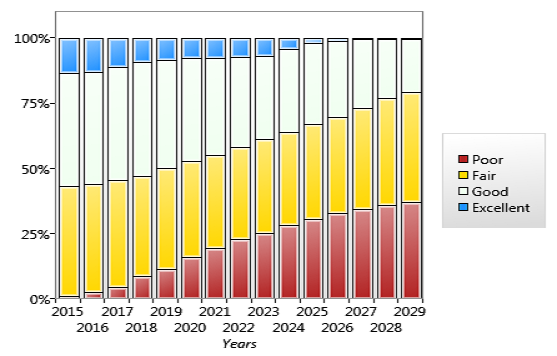By Edgardo Block, Connecticut Department of Transportation
One of the key findings of applying optimization methods to the problem of investing in pavement networks to meet certain objectives over an appropriate time horizon is that the worst-first intervention strategy is generally not the most effective, at least using a benefit-to-cost criterion. There is ample evidence of this, perhaps most strikingly exhibited by the experience of the Kansas Department of Transportation as it implemented this philosophy (see chart below).
(Note: this chart has been copied and pasted from the presentation hyperlink above).
In order to achieve these results, however, it is necessary to provide an investment level that is sufficient to address the backlog of roads in poor condition using a pavement-management approach.
A relevant question is what happens when we implement a pavement-management driven investment strategy but the level of investment is not sufficient to prevent roads from falling into the “Poor” category. If it is true that maintaining roads in better condition provides better return on investment, it follows that the optimized strategy favors these projects to the detriment of addressing the roads in worst condition. This is borne out on the following charts, of average condition and condition distribution, drawn from an actual budget scenario for a transportation agency. The scenario achieves the goal of maintaining current network pavement condition over 15 years (actually, it marginally improves it): While average condition is maintained, the percent of length in “poor” condition increases from just over 1% in 2014 to almost 16% in 2029.
In this case, this makes me feel good about how my pavement-management system is working — but there is still the reality of an increasing length of pavements in poor condition that results from this management approach. This feature of the optimized strategy – how well the traveling public is prepared to deal with increasing lengths of poor pavements – has to be addressed somehow. At best, the road users could get used to these conditions if they understand the higher rate of return on investment of the optimized strategy. However, if the transportation system customers are not willing to be subjected to these poor conditions, this could create a backlash with the end result that the (demonstrably) more effective strategy is abandoned.
There are two questions that, if answered, can be of great use in supporting the optimized strategy under such a constrained-funding scenario:
1. What are the results of the same level of funding but using a worst-first approach?
2. How can “poor” roads be addressed without abandoning the optimized strategy?
A Pavement Management System can provide an answer to the first question by limiting interventions to those at lower condition levels. In the state DOT example above, a reconstruction-only strategy over the same period and at the same investment level leads to 37% poor roads at the end of 15 years– and in the above example, non-pavement-related costs are excluded, so the result is likely to be much worse if right-of-way, maintenance-of-traffic, and other project complexity is built into the forecast.
(These two graphs were obtained by using the same $140M investment level as the optimized strategy, but limiting treatment options to “capital improvement” projects, i.e. reconstruction, rubblization, full-depth reclamation.)
Based on traditional practice, however, the strategy is not likely to be to reconstruct but to apply some remedial treatment that would be less costly but achieve some improvements. The result in that case would be to arrive to a state of “network mediocrity,” probably still with a significant length of roads in poor condition. This can also be simulated with a pavement management system by adding a remedial treatment with its own expected performance model and treatment application rules. The most negative implication of this approach is that the structural backlog of pavements is not addressed at all, making it that much more difficult to ever improve network conditions beyond that mediocre state achieved – doing that would entail major rehabilitation or reconstruction of the majority of the network.
The answer to the second question gets to the point of my post: Let’s say that, like me, you as pavement manager have not set up such a remedial treatment in the Pavement Management System. It is still possible to estimate the required effort to deal with the “poor-road backlog” by looking at PMS output. This can be done by applying a unit cost and expected duration to a “typical” remedial treatment. Assuming that all poor roads are unacceptable to “road customers,” it is possible to use the miles of poor pavement (lane-miles, preferably) and an expected remedial-treatment duration to assign a cost to achieving this objective of addressing poor roads. At the end of the life of the treatment, a subsequent remedial treatment would have to be applied, to the end of the analysis period. In the case above with a 15-year analysis period, and using a remedial treatment lasting 5 years, the roads that are listed as poor in the initial years would receive up to three remedial treatments. Estimating program size to control the length of pavements in poor condition then becomes an accounting and engineering-economics exercise solvable in Excel. To get the number of miles required each year the new poor miles are added to those for which the remedial treatment duration has expired; the program costs can be brought to present values or to an equivalent annual uniform cost and then the funding source can be sized appropriately.
A major caveat is that unless funding for this remedial program is provided from a separate source, this will take away funds from an optimized strategy, thus reducing the ability to achieve a network objective such as maintaining current network condition. An iterative process of adjusting (reducing) the optimized funding and recalculating the size of the remedial program is going to be required to develop actual condition targets. And, as always, project-level pavement evaluation and management have to be part of the equation to arrive at the actual projects delivered with such a program.
Lastly, it must be stressed that there is no panacea in the remedial-treatment management of poor roads: they will still require major investments for their condition to be improved. But what an explicit remedial-treatment program can do is minimize the amount of funding allocated to a worst-first strategy while maintaining the optimized strategy, which is where the real return on investment is. Ideally, the remedial treatment, with costs and performance predictions, would be built into the pavement management system. If – like me – you are not quite there yet, it is still possible to use your PMS to provide a reasonable approximation.
For more information, please contact Edgardo Block at Edgardo.Block@ct.gov




